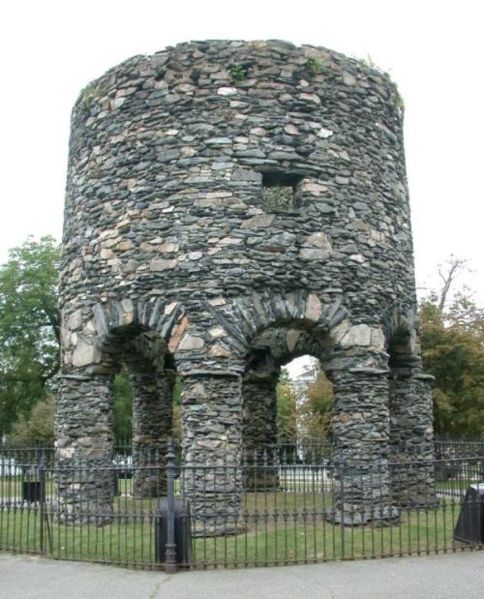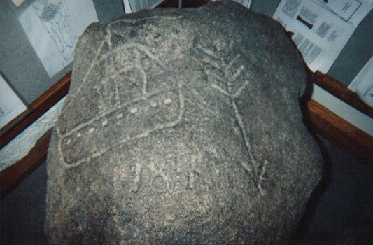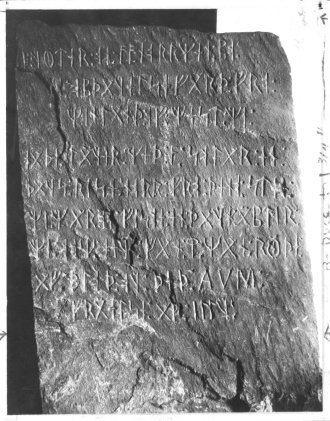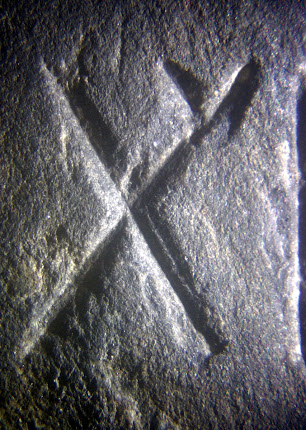I've received a number of queries asking for my reaction to the America Unearthed episode featuring the Bat Creek Stone ("Lost Relics of the Bible").
Overall, I thought it was one of the series' best episodes. Scott for the most part stuck to science and did a good job introducing the Bat Creek Stone as an important artifact. However, I would have liked to have seen three points expanded upon (yes, I know it is only an hour episode but there is so much repetition in this series that there is plenty of time to dive deeper into the investigations):
1. It could have been made clearer that the stone would have needed to be in the ground for many decades (centuries?) in order for the residue to wash away from the grooves--that is why Scott thinks it is ancient. Water would have penetrated the mound and slowly "bathed" the stone and cleaned out the grooves. Again, this would have taken many years, which points to the artifact's authenticity. (My guess is that Scott made this point but it was lost in the editing process.)
2. I would have liked Scott to have talked about the artifacts and bones found in the burial mound beneath the carved stone. The Cherokee tribal leaders have asked the Smithsonian to return the bones and artifacts so the tribe could test them but, last I heard, the Smithsonian was claiming they had been lost. I am not big into conspiracies, but this type of thing makes people wonder if there is some kind of cover-up going on. I'm surprised Scott didn't pursue this angle.
3. I would have also liked to see a stronger rebuttal directed at the naysayers who, inevitably, accuse the Smithsonian field agent who found the stone (John Emmert) of perpetuating a fraud or hoax, apparently in order to impress his boss. Here is a quote from one skeptic:
"John W. Emmert, a Smithsonian agent who conducted the 1889 excavation, forged the stone by disguising Paleo-Hebrew text copied from the 1870 Masonic text in order to create 'Cherokee' writing so he could impress his boss, Cyrus Thomas, by discovering pre-Columbian Native
writing."
http://www.jasoncolavito.com/1/post/2014/02/review-of-america-unearthed-s02e10-lost-relics-of-the-bible.html
So, instead of simply copying from other Cherokee script (examples of which existed as early as the 1810s), Emmert found a Masonic text, took from it Paleo-Hebrew writing, disguised it by turning it upside down, and then tried to pass it off as Cherokee... I'm sorry, my head hurts. Why go through such a convoluted process? And why would Emmert attempt to impress his boss with an artifact that was, frankly, unimpressive? (Remember, Emmert never claimed the artifact was Hebrew; in fact, his field notes show the carving drawn upside down.) He reported finding a stone carved with Cherokee writing in a Cherokee burial mound. Yawn. Hardly the type of discovery that leads to a promotion.
More to the point, nobody (including the Smithsonian) questioned the authenticity of the find until almost a hundred years after its discovery--only after Hebrew experts flipped the stone 180 degrees and concluded the script was Hebrew rather than Cherokee did anyone begin to question Emmert and his motivations. And does anyone else see the irony of the Smithsonian questioning its own employees? Should we thus assume other Smithsonian employees have also altered historical artifacts?
Regarding the naysayers, I am continually amazed by how zealously some critics attack Scott and his research. I do not agree with all of Scott's conclusions, but I do feel many of them are valid or at least merit further investigation. But the critics (easy enough to find through a Google search) have almost a visceral reaction every time Scott reaches a conclusion that runs contrary to accepted dogma. I understand that some of this criticism is borne of jealousy (one vociferous critic has repeatedly and unsuccessfully auditioned to play a host role similar to that played by Scott in America Unearthed). But there is an emotional, quasi-irrational aspect to these criticisms as well, with name-calling, personal attacks and intentional distortion of Scott's words.
I had some personal experience with one of these naysayers a couple of years ago. As part of the early planning for the show that would become America Unearthed, Scott asked me to travel to Tennessee with a film crew to investigate the Bat Creek Stone and do some interviews (Scott had to be at a wedding and could not go himself). One of the people we interviewed was an archeology professor from the University of Tennessee. He opined that the Bat Creek Stone was a fake. When I asked if his opinion would change if the artifacts found in the burial mound were tested by a reputable lab and the results showed the bones in the mound dated back to the first century AD and DNA showed a Middle-Eastern origin, he answered 'no.' When I asked why, he said that since he knew there were no explorers here before Columbus, any testing that showed otherwise must be flawed. He suggested that, in my scenario, somebody would have had to have somehow rigged the test. Nothing like making the evidence fit your theory!
I fear many others are equally close-minded, ignoring compelling evidence as they cling to their "Columbus first" dogma like a small child unwilling to let go of his or her belief in the Tooth Fairy.
The Newport Tower

Medieval stone tower ... in Rhode Island. Does it look like any other Colonial structure you've seen? Recent carbon dating of the mortar indicates 1400s construction date (see post below).
The Westford Knight Sword
Medieval Battle Sword ... in Westford, Massachusetts. Can anyone deny the pommel, hilt and blade punch-marked into the bedrock?
The Spirit Pond Rune Stone
Medieval Inscription ... in Maine, near Popham Beach. Long passed off as a hoax, but how many people know the Runic language? And how is it that some of the Runic characters match rare runes on inscriptions found in Minnesota and Rhode Island? Carbon-dating of floorboards at nearby long house date to 1405.
The Narragansett Rune Stone

Medieval Inscription ... in Rhode Island's Narragansett Bay. This Runic inscription is only visible for twenty minutes a day at low tide--is this also the work of a modern-day, Runic-speaking hoaxster?
The Westford Boat Stone

Medieval Ship Carving ... in Westford, MA. Found near the Westford Knight site. Weathering patterns of carving are consistent with that of 600-year-old artifact. And why would a Colonial trail-marker depict a knorr, a 14th-century ship?
The Kensington Rune Stone

Medieval Inscription... in Minnesota. Forensic geology confirms the carvings predate European settlement of Minnesota--so did Runic-speaking Native Americans carve it?
The Hooked X Rune

Medieval Runic Character ... on inscriptions found in Maine, Minnesota and Rhode Island. But this rare rune was only recently found in Europe. This conclusively disproves any hoax theory while also linking these three artifacts together.
Tuesday, February 4, 2014
Subscribe to:
Posts (Atom)